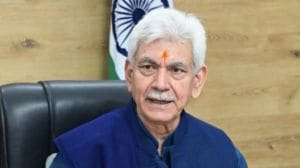Why Bangladesh celebrates Pohela Boishakh on April 14
Bengali New Year celebration: Pohela Boishakh is literally the first day (pohela) of Boishakh, the first month in the traditional Bengali calendar.
 A Pohela Boishakh procession in Dhaka this year. (Reuters)
A Pohela Boishakh procession in Dhaka this year. (Reuters)Pohela Boishakh in Bangladesh: Bangladesh has been celebrating Pohela Boishakh, the Bengali New Year, on April 14 since 1987. In India, however, Pohela Boishakh can fall either on April 14 or 15. Here’s why.
Story of Bengali calendar
Pohela Boishakh is literally the first day (pohela) of Boishakh, the first month in the traditional Bengali calendar. Bangabda or the “Bengali Era” begins in 594 CE, meaning that year zero in the Bengali calendar is year 594 of the Gregorian one. But exactly when this calendar, which is based on the Sanskrit treatise Surya Siddhanta, was first used is unclear.
Some historians credit King Shashanka of Gaur (reined 590-625 CE) for introducing the calendar. However, there is no contemporary evidence that directly supports this claim. “The earliest reference to Bangabda occurs in two Shiva temples in Bankura district, one at the village Dihargram and the other at Sonatapan. Both these temples are around a thousand years old,” Nitish Sengupta wrote in Land of Two Rivers: A History of Bengal from the Mahabharata to Mujib (2011).
What can be said with certainty, however, is that the present calendar took shape in the reign of Akbar. “Akbar asked the royal astronomer Amir Fatehullah Shirazi to formulate a new calendar based on the lunar Hijri and the solar Hindu calendar… scheduled to start after the harvesting season… [it] was hence called fasholi shan (harvest calendar),” historians Kunal and Shubhra Chakrabarti wrote in The Historical Dictionary of the Bengalis (2013).
The Sanskrit names of the months were retained, but the calendar started with the Hijri calendar value. This calendar contained 365 days, with some months having 29 days and others 32. Boishak, the first month of this calendar, began in mid-April.
Bangladesh’s calendar
The Bangla Academy in Dhaka appointed a committee under Muhammad Shahidullah in 1966 to make the Bengali calendar “more precise”. The committee recommended that the first five months of the year should consist of 31 days and the remaining seven months of 30 days each, with the addition of an extra day to the month of Falgun (mid-February to mid-March) every Gregorian leap year.
The revised calendar was adopted by Bangladesh in 1987. The country has celebrated Pohela Boishakh on April 14 since then.
However, these changes have not been incorporated into the calendar followed in West Bengal and elsewhere in India. According to Kunal and Shubhra Chakrabarti, this is because “the traditional calendar is inextricably associated with Hindu religious festivals… the number of days in a month is determined by the actual motion of the sun through the zodiac” meaning the lengths of the months cannot be fixed.
Pohela Boishakh is celebrated either on April 14 or 15 in India.






- 01
- 02
- 03
- 04
- 05
































